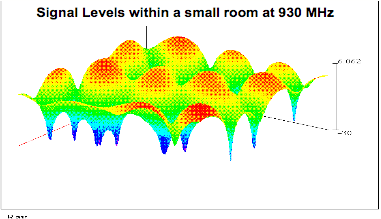- Products
- All Products
- RF PA Extension Kit
- Wireless Microphone Upgrade Packs
- In-Ear Monitor Upgrade Packs
- Wireless Microphone Antennas
- Wireless In-Ear Monitor Antennas
- Antenna Distribution for Microphones
- Antenna Combiners for In-Ear Monitors
- Multi-Zone Antenna Combiners
- Spectrum Tools
- Accessories, Cables and Parts
- Solutions by Venue
- Resources & Training
- Performance Tools
- About Us

Many of you know diversity receivers work by choosing the stronger of two signals from antennas placed a physical distance apart. The likelihood of a multi-path interference null developing over both antennas at once is much lower than if the receiver has only one antenna. Many professionals who use external diversity kits, like paired LPDA/paddles antennas, have been told the two antennas should be spaced apart a certain distance. Usually, 1/4 or 1/2 of a wavelength of the operating frequency. Others assume that if 1/4 of a wavelength is good, a full wavelength or more (sometimes much more) will be better.
There is no proven theory behind the 1/2 and 1/4 wave rules of thumb. In our experience, spacing antennas a certain distance apart does not produce any appreciable reduction in dropouts over spacing them a few inches if the antennas are kept on the same polarization plane.
Likewise, there is a mistaken belief that spacing antennas some large distance apart, like dozens of feet, will create performance improvements proportional to that distance. It may not hurt performance, but it won’t improve it over some other arbitrarily smaller distance.
Diversity antenna placement relies on the probabilitythat if one antenna is inside a null, an antenna somewhere else will not be in the same null. And this is true for an individual dead spot. But nulls exist in multiple locations, and can exist quite close together, and in all sorts of complex shapes and sizes.
Spacing the distance of 1/2 a wave apart will do the job. The likelihood of reducing multi-path interference events will be lower than it would be were you to use a single antenna, but it is not a magic number.
Likewise, by spacing two antennas five, six, or seven feet apart, you certainly have a higher probability of reducing dropouts, but you don’t eliminate the placing the second antenna in another null somewhere else.
 Simulation of multi-path nulls as they might appear in a small, simple room. Image courtesy Selwyn Hill, via the Paging Information Resource.
Simulation of multi-path nulls as they might appear in a small, simple room. Image courtesy Selwyn Hill, via the Paging Information Resource.
So what is the right distance to space a diversity pair? There isn’t one. It is almost impossible to predict where nulls will develop inside a room, even with super expensive radio wave propagation simulation software, so it isn’t really true that there is one golden rule of spacing that will create an optimum set of diversity signals sent to the receiver.
However it is possible to have the antennas too close together. When the two are very close, they start interacting in the near-field with one another and act as a single antenna. Exactly where this happens depends on a number of factors, like frequency and antenna type, but it is unlikely to happen unless they get very close - too close for comfort.
Image courtesy Florian Weber.
On the old blog, we had comments (which we will have again, once we figure out how to turn them on.) Former OET Chief and current Vice President of Spectrum Policy Robert Weller weighed in on this topic in the comments, as well as Australia's most knowledgable wireless audio pro, Steve Caldwell.
Weller: Antenna diversity only works in a multipath-fading environment. In a line-of-sight environment, it is impossible to generate two uncorrelated fading signals. Since most wireless audio applications are approximately line-of-sight, diversity reception offers only a modest improvement regardless of the antenna separation distance.
Me: Hi Robert, we have done some research into multipath using diversity mic receivers and found using polarization planes as the two variables with our orthogonally cross-polarized Diversity Fin is extremely effective at reducing dropouts caused by multipath. Check it out: http://www.rfvenue.com/blog/2014/12/15/demonstrating-polarization-diversity-with-the-shure-ulx-d
Weller: Polarization diversity is a different story from spatial diversity. While both rely on decorrelation, the underlying mechanisms are different. Using RHC and LHC receive antennas in a pol-diversity arrangement should achieve optimum results when the transmitting antennas are linearly polarized, but I cant recall ever seeing such an application. When CP antennas (such as helicals) are used, they have the same sense of rotation. Some improvement would be expected if they were sold in pairs with opposite polarizations.
Caldwell: Hi Alex, As usual, great article. It should be pointed out that modern diversity receivers don't just use RSSI (received signal strength) to determine diversity activity in the receiver, that is, which antenna (or both) to use, they are a lot more involved than this. More often, demodulated signal quality is used to determine this. This is normally in the fashion of detecting any out-of-audio-band noise present in the demodulated audio, rather than the strength of the RF signal itself. For this reason, the two diversity antennas should be placed far enough apart to be of value spacially, but not so far apart that they would be influenced by significantly different noise levels from other RF sources. More demodulated noise in one antenna will tend to make the receiver favour the alternate antenna, regardless of the RF signal strength from the transmitter its tuned too. This limits the viability of diversity significantly. Similar to this is using different gain settings on the two different antennas. I also agree with your assessment of there being no hard and fast rule regarding the distance between two diversity antennas, and the only time I have taken this distance into account seriously is when the distance from the antennas to the transmitter is excessive. I have found that if the diversity 'triangle' get to accute, then you start to loose diversity effectiveness. For TX to RX antenna distances over 150', I will significantly increase the distance between the two diversity antennas. This has proven to be a most effective principle.
Steve
Tag(s):
Knowledge Guides
Alex Milne
Alex Milne was Product Marketing Manager and Digital Marketing Manager for RF Venue, and a writer for the RF Venue Blog, from 2014-2017. He is founder and CEO of Terraband, Inc., a networking and ICT infrastructure company based in Brooklyn, NY., and blogs on spectrum management, and other topics where technology,...
More from the blog

2.4 GHz CP Beam
RF Venue Antennas Support Times Square Musical Festival
1 min read
| December 15, 2014
Read More

CP Beam Antenna
Jason Glass Talks Wireless for the 2015 CMA Music Festival
5 min read
| June 25, 2015
Read More

Knowledge Guides
Take a Bite out of Interference with "Shark Fin" LPDA Antennas
3 min read
| December 14, 2014
Read More
Subscribe to email updates
Stay up-to-date on what's happening at this blog and get additional content about the benefits of subscribing.

